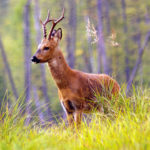Podolskiy S.A. Environmental Hazard of Selemdzha and Lower Zeya Hydroelectric Power Stations // Ecosystems: ecology and dynamics. No 2. 2023. P. 176-190. | Abstract | PDF | Reference
- Filling of the Bureya Reservoir (photo by S.A.Podolsky)
- A hut that was flooded by the water from the Bureya Reservoir (photo by S.A.Podolsky)
- Construction of the dam of the Bureya Hydroelectric Power Station (photo by S.A.Podolsky)
- Roe deer walking away (photo by S.A.Podolsky)
- Roe deer on the left bank of the Zeya River in the Gramatuha Natural Boundary (photo by S.A.Podolsky)
- Hooded crane taking off (photo by S.A.Podolsky)
- Hooded cranes (photo by S.A.Podolsky)
- Red-crowned cranes (photo by S.A.Podolsky)
- Oriental stork (photo by S.A.Podolsky)
- Lenok or Asiatic trout (photo by S.A.Podolsky)
- Roe deer fawns swimming (photo by S.A.Podolsky)
- Roe deer at the Nora River crossing (photo by S.A.Podolsky)
On April 5, 2023, Teleport.RF (2023) cited the Russian News Agency TASS that reported about RusHydro’s decision to build the Selemdzha and Lower Zeya Hydroelectric Power Plants in the Amur Region. After several settlements in the Far East were flooded, the federal authorities ordered hydroconstructors “to design and create hydraulic structures in the Amur River basin to protect the local population from floods”. An exact fulfillment of this order can lead to an ecological catastrophe for the entire Amur Region.
The Amur River and its tributaries have extremely high (up to 270 times) natural fluctuations in runoff, from 150 to 40,000 m3/sec, the maximal volume for this country. The creation of large reservoirs with the necessary flood protection tanks will be followed by many negative environmental and social consequences.
The construction of Selemdzha and Lower Zeya Plants cannot control the floods, but it will guarantee many critical problems in the future. The Selemdzha Dam will cause several large settlements, a section of the Baikal–Amur Mainline and regional highways disappear under water. The final water area will be about 800 km2. Violating the Russian law on specially protected nature areas, Selemdzha Reservoir will flood most of the Nora Nature Reserve, while irreparably damaging the remaining protected terrestrial ecosystems. These wetlands provide valuable habitats for at least 29 rare and protected bird species, for some of which the seasonally flooded habitats are of major regional and sometimes global importance. For example, the black stork has a uniquely high population density there, about 1 ind. per 100 km2, while the Oriental stork and the red-crowned crane use it for their northernmost nesting site. Additionally, it’s the habitat of a large and isolated nesting group of the hooded crane and the only stable group of Blakiston’s fish owl in the Amur Region.
The future location of the Selemdzha and Lower Zeya dams, while amplifying the negative impacts of both reservoirs, will have an inevitable and severe cumulative effect on local ecosystems. First of all, this will destroy the last large migratory groups of the Siberian roe deer, contrary to the Russian law on wildlife, and cause a sharp drop in the biodiversity of the north part of the Amur Region. The Selemdzha Reservoir will make the main breeding grounds inaccessible, while the Lower Zeya Reservoir will block the paths leading roe deer to their wintering sites. Simultaneous flooding of valley biotopes in the middle reaches of the Zeya and Selemdzha Rivers will block the main ecological corridors, therefore destroying the habitats of many rare species of both animals and plants.
The danger of these projects has already been confirmed by expert’s researches and opinions. Thus, the Selemdzha (Dagmar) Hydroelectric Power Plant project was rejected by the USSR environmental review; the environmental hazard of the Lower Zeya Plant was proven in a report provided as part of the program “Russian Ministry of Natural Resources – United Nations Development Program/Global Environment Facility”. The optimal solution to this problem is to consider the construction of new hydroelectric facilities not as a universal measure, but as a part of the presented comprehensive program to prevent negative social consequences from floods. In the Amur Region the hydropower plants can be placed in a way that fully complies with such approach: e.g. Ekimchan (upper reaches of the Selemdzha River) and Upper Ninam (upper reaches of the Niman River, left tributary of the Bureya River) promising sites where the construction of hydroelectric plants would require the lowest social and ecological costs. An objective analysis shows that the decision to build the Selemdzha and Lower Zeya Plants meets only the departmental interests of hydro and power engineers. This one-sided approach cannot be allowed, because it will cause enormous environmental and socio-ecological damage to the region. Among other things, the positive idea of the federal authorities about effective assistance provided to the locals will be pretty much discredited. On the other hand, the choice of optimal sites and the rejection of the most environmentally hazardous ones, as well as an integrated approach to preventing the negative consequences of floods, will make it possible to take a step towards the environmentally sustainable development of the Amur Region.
Keywords: flood control, Selemdzha and Lower Zeya Hydroelectric Power Plants, environmental hazard, disrupted migrations, Siberian roe deer, rare bird species, biodiversity decline.
Funding. This work was carried out for the Water Problems Institute of the Russian Academy of Sciences, topic No. FMWZ-2022-0002 “Research of Geoecological Processes in Hydrological Land Systems, in Formation of the Quality of Surface and Ground Water, Problems of Water Resources Management and Water Use under Climate Change and Anthropogenic Impacts”, as well as for the Zeya State Nature Reserve, State Order No. 051-00007-22-00 “Dynamics of Phenomena and Processes in the Ecosystems of the Zeya Reserve and Tokinsko-Stanovoy National Park”.
DOI: 10.24412/2542-2006-2023-2-176-190
EDN: DGFWBG



























